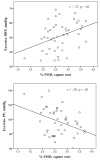Flow-mediated dilation and exercise blood pressure in healthy adolescents
- PMID: 23809838
- PMCID: PMC4020997
- DOI: 10.1016/j.jsams.2013.05.015
Flow-mediated dilation and exercise blood pressure in healthy adolescents
Abstract
Objectives: Exercise blood pressure is a robust predictor of cardiovascular disease risk. Endothelial dysfunction occurs early in development of cardiovascular disease and is associated with greater exercise blood pressure in adults. However, it is not yet clear whether endothelial function is associated with exercise blood pressure in youth. The purpose of this study was to examine the relationship between endothelial function, indexed by brachial artery flow-mediated dilation, and submaximal exercise blood pressure in healthy adolescents.
Design: Cross-sectional study.
Methods: Adolescents (N=45) completed a graded submaximal treadmill test. Blood pressure was measured during rest and each exercise stage. Ultrasound measurement of brachial artery flow-mediated dilation was completed on a separate visit. Pearson correlations and multiple regression were used to assess the unadjusted and multivariate adjusted associations between flow-mediated dilation and exercise blood pressure, respectively.
Results: Lower flow-mediated dilation was associated with lower diastolic blood pressure (r=0.37, p=0.01) and greater pulse pressure (r=-0.38, p=0.01) during exercise. The significance did not change when adjusting for age, gender, fitness, or resting blood pressure. Exploratory analyses suggest that flow-mediated dilation was associated with exercise diastolic blood pressure primarily among adolescents with low resting diastolic blood pressure.
Conclusions: Studies in youth are important to understand the early pathogenesis of cardiovascular disease. Findings from this study suggest that endothelial function may play a role in regulating blood pressure responses during submaximal exercise in healthy adolescents.
Keywords: Blood pressure; Cardiovascular disease; Endothelial function; Exercise; Youth.
Copyright © 2013 Sports Medicine Australia. All rights reserved.
Figures
References
-
- Mundal R, Kjeldsen SE, Sandvik L, et al. Exercise blood pressure predicts cardiovascular mortality in middle-aged men. Hypertension. 1994;24(1):56–62. - PubMed
-
- Singh JP, Larson MG, Manolio TA, et al. Blood pressure response during treadmill testing as a risk factor for new-onset hypertension. The Framingham heart study. Circulation. 1999;99(14):1831–1836. - PubMed
-
- Li S, Chen W, Srinivasan SR, et al. Childhood cardiovascular risk factors and carotid vascular changes in adulthood: the Bogalusa Heart Study. JAMA. 2003;290(17):2271–2276. - PubMed
-
- Raitakari OT, Juonala M, Kahonen M, et al. Cardiovascular risk factors in childhood and carotid artery intima-media thickness in adulthood: the Cardiovascular Risk in Young Finns Study. JAMA. 2003;290(17):2277–2283. - PubMed
Publication types
MeSH terms
Grants and funding
LinkOut - more resources
Full Text Sources
Other Literature Sources
Medical


